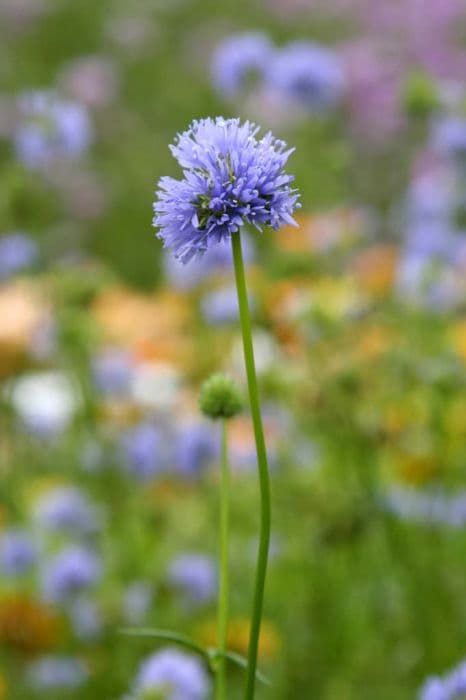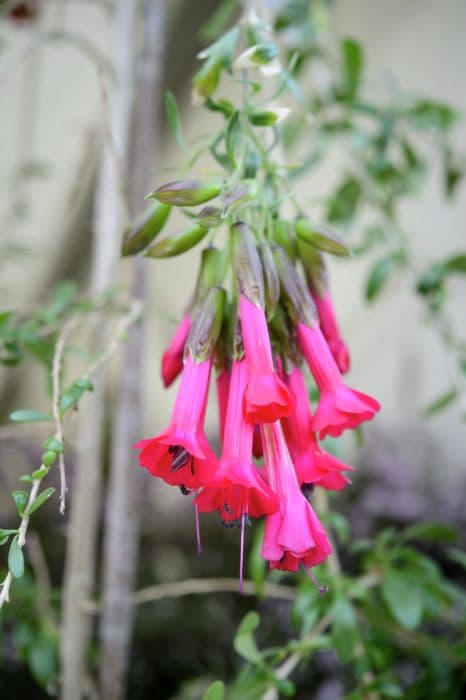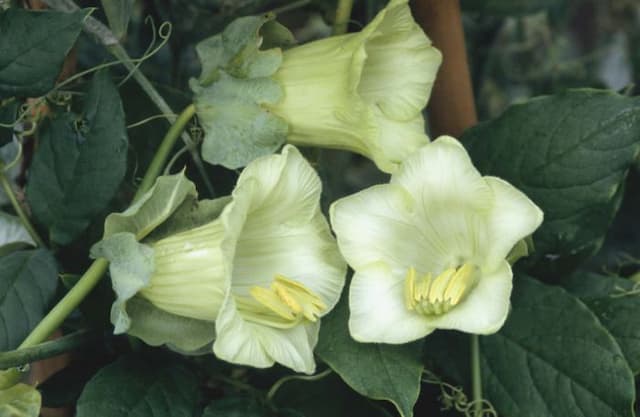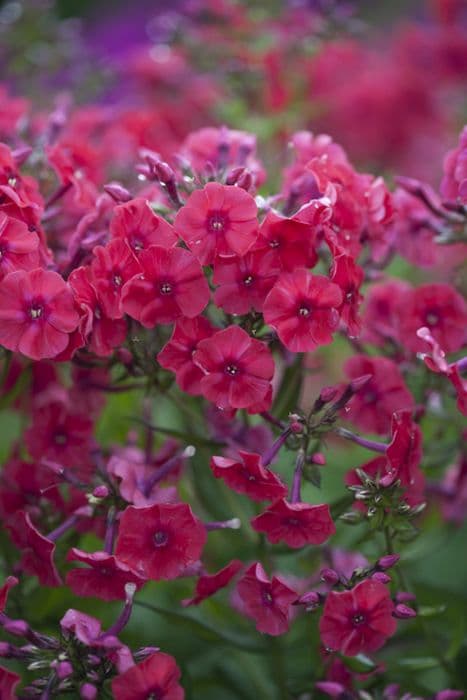Garden Phlox Phlox paniculata 'Rembrandt'

ABOUT
Phlox paniculata 'Rembrandt', commonly known as garden phlox, is a herbaceous perennial that is admired for its attractive flowering clusters. This cultivar produces panicles of blossoms that come in a delightful shade, typically featuring a playful variation of colors that can include a mix of pinks and purples with subtle white accents. The individual flowers are small and tubular, with five rounded petals spreading out from a narrow tube, typically presenting a soft, eye-catching aesthetic with their vibrant hues. These flowers are densely packed in clusters atop stems that bear lance-shaped leaves. The foliage of the garden phlox is a deep green color and offers a lush background that allows the colors of the 'Rembrandt' blooms to stand out prominently. The leaves themselves are smooth with a slightly glossy appearance, having a pointed tip and a well-defined vein structure that adds texture to the plant. Garden phlox as a whole is known for its bushy growth habit, with 'Rembrandt' producing a generous spread of leaves and flowers to create a full and robust presence in the garden. This plant can become a focal point when in bloom, offering both visual appeal and a sweet, pleasant fragrance that can attract butterflies and hummingbirds. The overall impression given by the garden phlox 'Rembrandt' is one of a charming and colorful plant that adds brightness and a sense of vitality to the landscape.
About this plant
 Names
NamesFamily
Polemoniaceae
Synonyms
Garden Phlox, Summer Phlox, Perennial Phlox, Fall Phlox
Common names
Phlox paniculata 'Rembrandt'.
 Toxicity
ToxicityTo humans
Garden phlox is generally not considered toxic to humans. There is limited information on the toxicity of Phlox paniculata 'Rembrandt', but as with many plants, it is advisable to avoid ingesting any parts of it without proper knowledge of its edibility. If a person suspects poisoning from consuming any part of the garden phlox, they should seek medical attention.
To pets
Garden phlox is not known to be toxic to pets either. However, as with humans, it is best to prevent pets from eating plants unless you are certain of their safety since individual animals may have different sensitivities. If a pet exhibits unusual symptoms after consuming garden phlox, consult a veterinarian.
 Characteristics
CharacteristicsLife cycle
Perennials
Foliage type
Deciduous
Color of leaves
Green
Flower color
Pink
Height
2-3 feet (0.6-0.9 meters)
Spread
2-3 feet (0.6-0.9 meters)
Plant type
Herb
Hardiness zones
4
Native area
North America
Benefits
 General Benefits
General Benefits- Vibrant Aesthetics: The Phlox paniculata 'Rembrandt', commonly known as Garden Phlox, has striking purple-pink flowers that add color and beauty to any garden setting.
- Attracts Pollinators: Garden Phlox is known for attracting butterflies, hummingbirds, and bees, promoting biodiversity in your garden.
- Fragrance: The blooms of Garden Phlox emit a sweet fragrance that can create a pleasant olfactory experience in outdoor spaces.
- Long Blooming Period: Garden Phlox has a long flowering season, usually from mid-summer to early fall, providing long-lasting visual interest.
- Easy to Grow: This plant is relatively easy to cultivate in a variety of soil types, as long as there is good drainage and it receives adequate sunlight.
- Drought Tolerance: Once established, it can tolerate periods of drought, making it suitable for gardens with less frequent watering.
- Habitat Enrichment: By adding structure and shelter, Garden Phlox can contribute to enriching the habitat for various garden fauna.
- Border and Background Plant: Its tall stature makes it ideal for using in the back of flower borders or as a backdrop for other garden plants.
- Cut Flower Use: Garden Phlox is a popular choice for bouquets and flower arrangements due to its attractive blooms and long vase life.
 Medical Properties
Medical PropertiesThis plant is not used for medical purposes.
 Air-purifying Qualities
Air-purifying QualitiesThis plant is not specifically known for air purifying qualities.
 Other Uses
Other Uses- Garden phlox can be used to create natural dye, with flowers providing varying shades of pink to purple, depending on the mordant used.
- The cut flowers of garden phlox can be used in floral arrangements, contributing bold color and a pleasing fragrance.
- Dried garden phlox petals can be incorporated into potpourri mixes to add color and a subtle scent.
- Garden phlox, when planted in masses, can serve as a natural privacy screen or as a border for garden paths.
- By planting garden phlox in outdoor learning environments, they can be used as a tool for teaching children about pollinators.
- Garden phlox's nectar-rich flowers can be used to attract and support beneficial insects for natural pest control within a garden.
- Garden phlox can be used in companion planting to lure away pests from more susceptible vegetables or fruits.
- The tall stems of garden phlox can be used as natural support stakes for lower-growing, floppy plants when planted nearby.
- The colorful presence of garden phlox can be utilized in sensory gardens, as it appeals to both visual and olfactory senses.
- Photographers can use garden phlox as a vibrant, natural backdrop for close-up images of insects and other garden wildlife.
Interesting Facts
 Feng Shui
Feng ShuiGarden Phlox is not used in Feng Shui practice.
 Zodiac Sign Compitability
Zodiac Sign CompitabilityGarden Phlox is not used in astrology practice.
 Plant Symbolism
Plant Symbolism- Union of Souls: Phlox paniculata, commonly known as Garden Phlox, often symbolizes the unity of two souls, making it a fitting representation of marriage or deepening relationships.
- Harmony: The harmonious arrangement of the flowers in their dense clusters suggests a sense of balance and togetherness, often reflecting the desire for peaceful and harmonious relationships.
- Sweet Dreams: Garden Phlox is also associated with the conveyance of sweet dreams, as some Native American traditions believe that a bouquet of these flowers can ensure a tranquil sleep.
- Proposal: Because of its association with unity, presenting Garden Phlox can imply an offer of marriage, or at the very least, the intention to form a serious and lasting connection with someone.
 Water
WaterGarden Phlox (Phlox paniculata 'Rembrandt') prefers consistent moisture and should be watered thoroughly whenever the top inch of soil feels dry to the touch. Typically, this means watering about once a week, but this may vary depending on climate conditions such as temperature and humidity. When watering, aim to apply water directly to the soil rather than overhead to avoid wetting the foliage, as this can lead to fungal diseases. During peak summer months, they may need about 1 to 1.5 gallons of water per week, but always check soil moisture before watering.
 Light
LightGarden Phlox thrives in full sunlight and will produce the most abundant and healthy blooms when it receives at least six hours of direct sunlight each day. An ideal spot is an area with clear exposure to the sun throughout the day, though some afternoon shade can be beneficial in extremely hot climates to prevent scorching. Avoid heavily shaded spots as insufficient light can lead to weak growth and fewer flowers.
 Temperature
TemperatureGarden Phlox does well in a wide range of temperatures but prefers a climate where the temperatures are between 60 to 80 degrees Fahrenheit. It can survive minimum temperatures down towards 40 degrees Fahrenheit and maximum temperatures up to about 90 degrees Fahrenheit. However, extended periods outside of its ideal temperature range can stress the plant and affect its health and flowering.
 Pruning
PruningGarden Phlox should be pruned to encourage bushier growth, improve air circulation, and promote healthier blooms. Pruning should occur in early spring before new growth starts; simply cut back last year's growth to about 1 to 2 inches from the ground. Deadheading, or the removal of spent flowers, should be done throughout the blooming season to encourage further blooming and prevent self-seeding if not desired.
 Cleaning
CleaningAs needed
 Soil
SoilGarden Phlox thrives in a soil mix that is moist, well-draining, and rich in organic matter with a pH range of 6.0 to 7.0. A blend containing garden loam, peat moss, and perlite or coarse sand is ideal to ensure proper drainage and fertility.
 Repotting
RepottingGarden Phlox, a perennial, does not typically require frequent repotting. It can be divided every 3 to 4 years to rejuvenate growth and manage size.
 Humidity & Misting
Humidity & MistingGarden Phlox prefers moderate humidity and can tolerate the ambient outdoor humidity in most climates without the need for additional measures.
 Suitable locations
Suitable locationsIndoor
Ensure bright light, moist soil, and some humidity.
Outdoor
Plant in sun, enriched soil; water and mulch well.
Hardiness zone
4-8 USDA
 Life cycle
Life cycleThe life cycle of Phlox paniculata 'Rembrandt', commonly known as Garden Phlox, begins with seed germination which occurs in early spring under proper conditions, such as moist soil and appropriate temperatures. Seedlings emerge and grow into vegetative plants, developing roots, stems, and leaves through the spring season. As the plants mature, they enter the flowering stage in mid to late summer, producing clusters of vibrant, fragrant flowers that are attractive to pollinators like butterflies and hummingbirds. After pollination, the flowers develop into seed capsules, and when the seeds mature, they are dispersed by wind or wildlife, thus completing the reproductive cycle. In fall, Garden Phlox may die back, especially in colder climates, retreating to the soil level where it enters a period of dormancy in winter. During dormancy, the plant conserves energy until the return of favorable conditions in spring, at which point it resumes growth.
 Propogation
PropogationPropogation time
Spring to Early Summer
The most popular method for propagating Phlox paniculata 'Rembrandt', commonly known as garden phlox, is through stem cuttings. This is usually done in late spring or early summer when the plant is actively growing. A healthy, non-flowering shoot is chosen and a section of about 4 to 6 inches (approximately 10 to 15 centimeters) is cut just below a node. The lower leaves are removed, leaving several leaves at the top. The cut end is then dipped in rooting hormone powder to encourage root development and planted in a mix of peat and perlite. The cutting should be kept moist and in indirect light until roots have formed, which typically takes a few weeks, after which it can be transplanted to a more permanent location.









